Week 12: Applications and implications
The task for this week and the spring break is to plan and prepare for the final project, as well as wildcard machine making week. Initially, I proposed THIS as my final project, which is a LED wearable that sychonizes with BPM zone. After planning for wildcard week, I decide to investigate incoporating fabric/fiber with pcb during that week instead. As for the final project, I am interested in making an interactive kinetic sculpture, which is based on the drawing series "Orbit-in-flux" I began last fall and a performance "Lover's Orbit" I did last summer. I will explain its concept in the following sections.
Final Project Masterplan
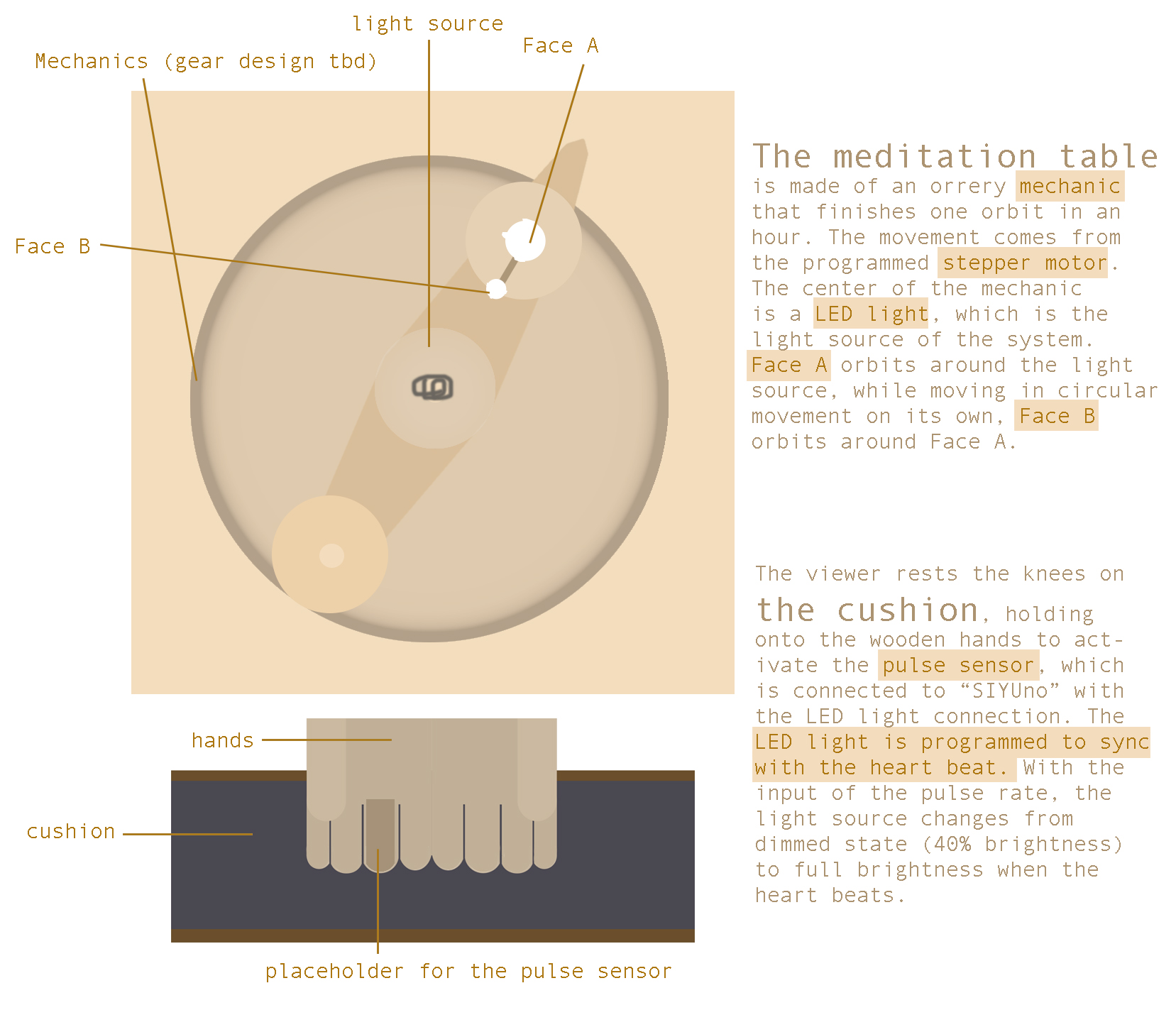
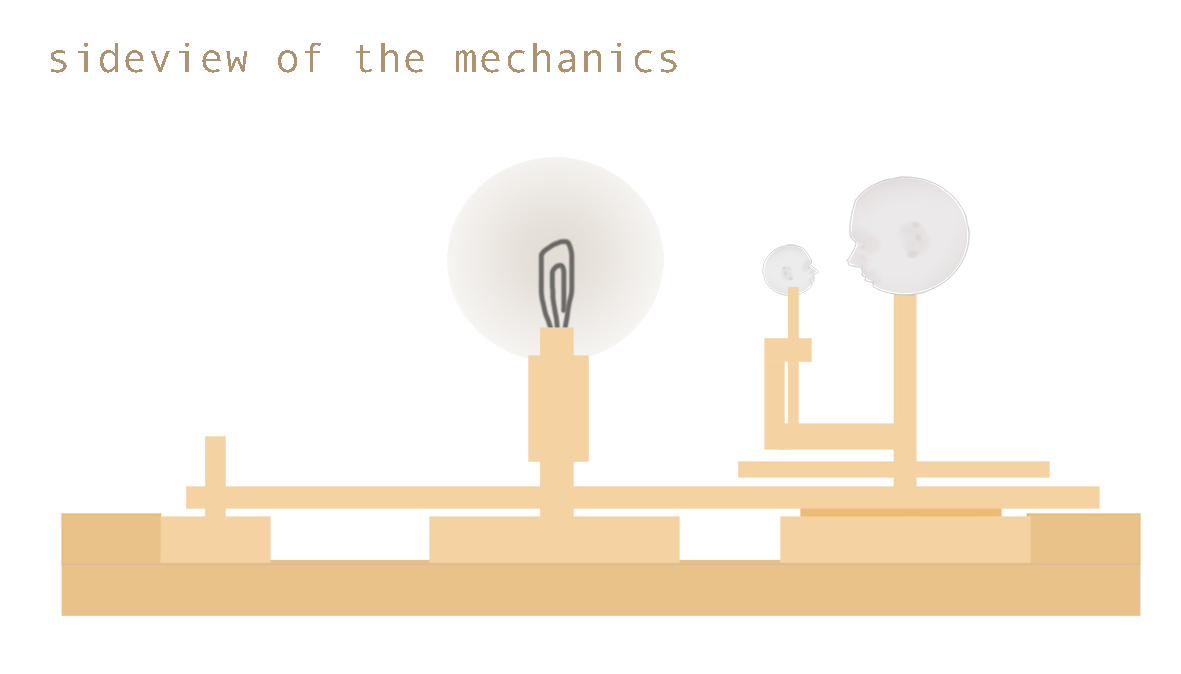
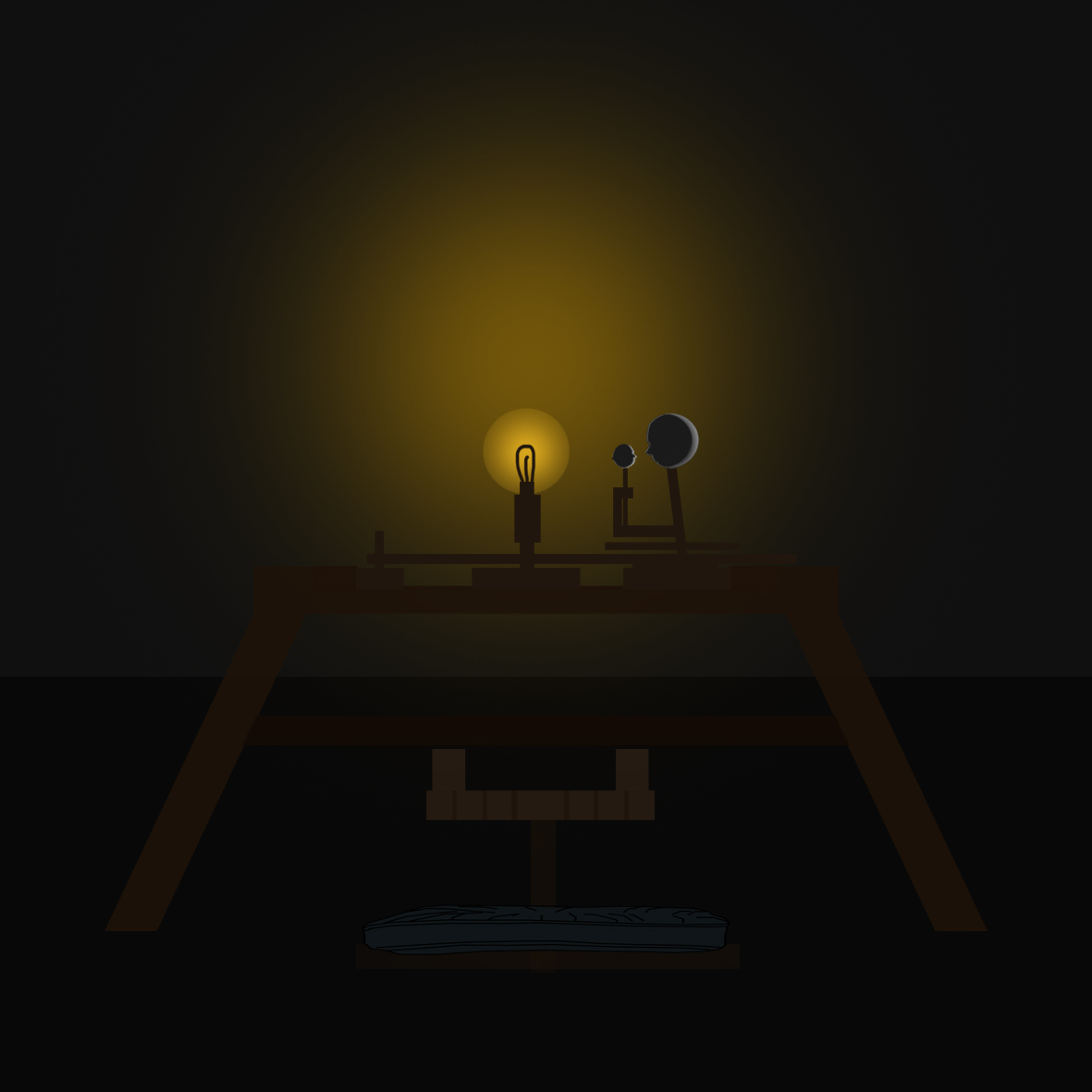
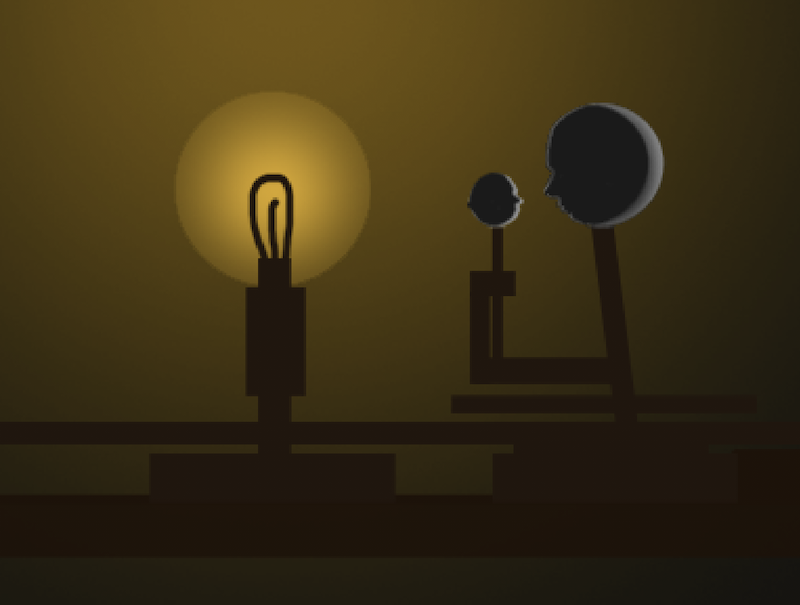
Physical description of the project
This interactive sculpture takes the mechanics of an orrery, with two faces being the earth and moon, light source being the sun. The light source remains dim, syncs with heart beat when the viewer puts the tip of the finger onto the pulse sensor in front of the sculpture. Light illuminates the faces (with some light partially blocked since the object is against the light) and its surroundings partially. The two faces finishes one orbit around the light source in one hour, while one face finishes one orbit around the other face in one minute.
The mechanics rest on a meditation table, which requires the viewer to knee down in front of the table in order to look at the sculpture and to input heart rate from the pulse sensor that is placed in front of the table.
Conceptual Development
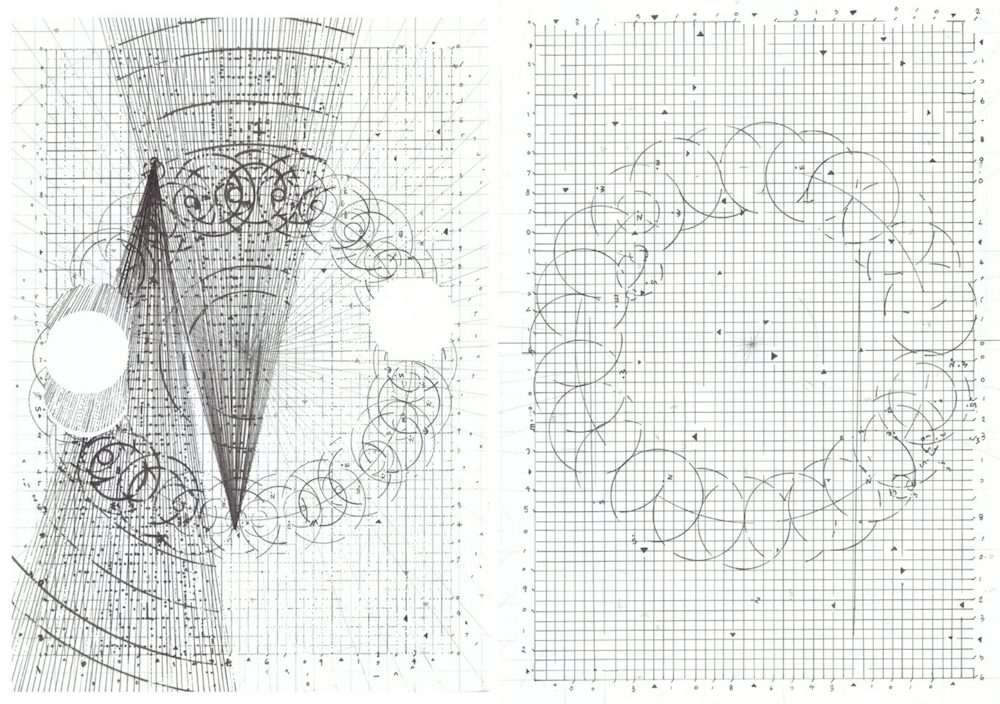
This interactive sculpture is a continuation of my investigation in the parallel between planetary orbit and human's perception of otherness, specifically in an intimate relationship. In the past performance I did collaboratively, I was more interested in the perception of otherness when one is in love. In this sculpture, I concerned with that in relation to pain.
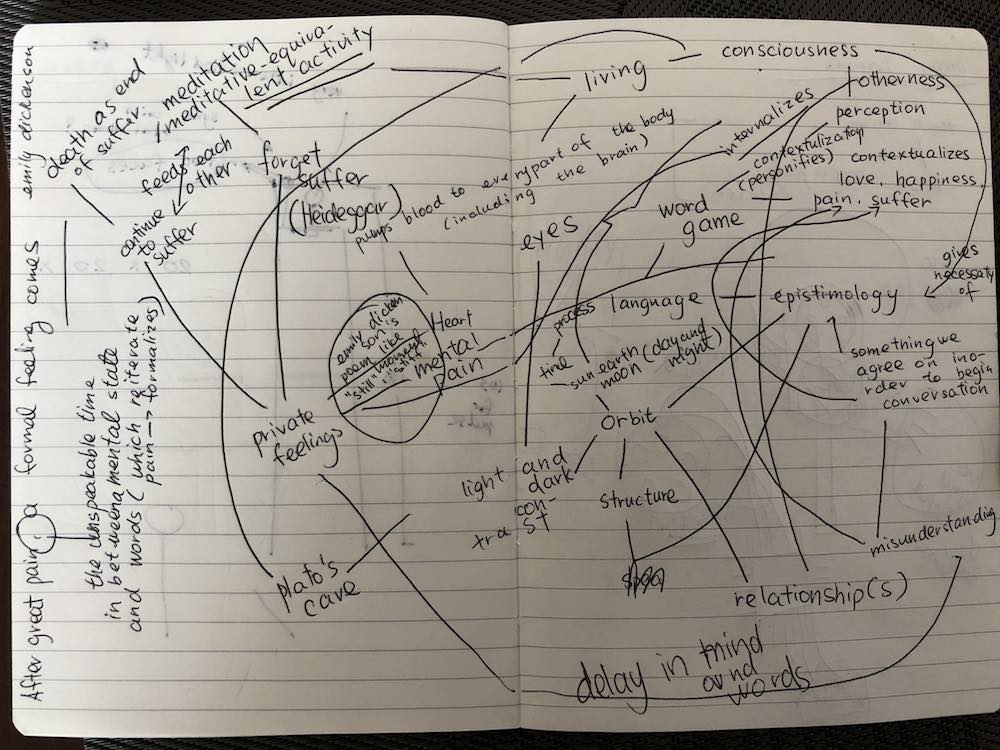
Emily Dickinson's poem After great pain, a formal feeling comes is an inspiration of mine. It delicately outlines the nature of pain. Metaphors such as tomb, ground, stone, quartz, stone, mechanics are assigned to different parts of the body in revealing the stiffness of the body when one is mentally in pain. At the end of the poem, the person that suffered from pain, written as ''the freezing person'', experiences the coldness of the snow, feeling ''stupor'' and ending the feeling with ''letting go''. The ''He'', cause of pain that stiffens the body, disappears.
After great pain, a formal feeling comes - (372) BY EMILY DICKINSON After great pain, a formal feeling comes - The Nerves sit ceremonious, like Tombs - The stiff Heart questions 'was it He, that bore,' And 'Yesterday, or Centuries before'? The Feet, mechanical, go round - A Wooden way Of Ground, or Air, or Ought - Regardless grown, A Quartz contentment, like a stone - This is the Hour of Lead - Remembered, if outlived, As Freezing persons, recollect the Snow - First - Chill - then Stupor – then the letting go - Source: The Poems of Emily Dickinson Edited by R. W. Franklin (Harvard University Press, 1999)
The light source of the sculpture remains dim at first, which is similar to the stiffness of the body after one experienced pain. One's relationship with the present comes into the foreground, as the light source activates by the pulse (touch), which is similar to the role of the snow in the poem. Since the only light source in the room comes from the center of the sculpture, it would hit on its closest objects, being the two faces orbiting like the earth and the moon. The viewer is the audience of the two faces (two person) in this scenario. The light and shadow on the faces, similar to the state of the moon, is different depending on the present position of the faces in the orbit. Therefore, the encounter of the state of the love is purely dependent on chance - the time when the viewer perceives the light and shadow on the sculpture with one's present heart state. The longer the viewer stays, the more of the orbit the viewer perceives.
The purpose for creating this orrery-like mechanism in the middle of a meditation table is to create a private and meditative viewing experience, where the viewer knees down to hold onto the hand and becomes the audience of two people in relation with each other. Often in great happiness or in great pain, one lacks the ability in being aware of the big picture. This sculpture purposes a solitary meditative experience for one to be the audience of the blindspot, with the hope of gently bringing wholeness into one’s body after great pain.
Who's done what beforehand?
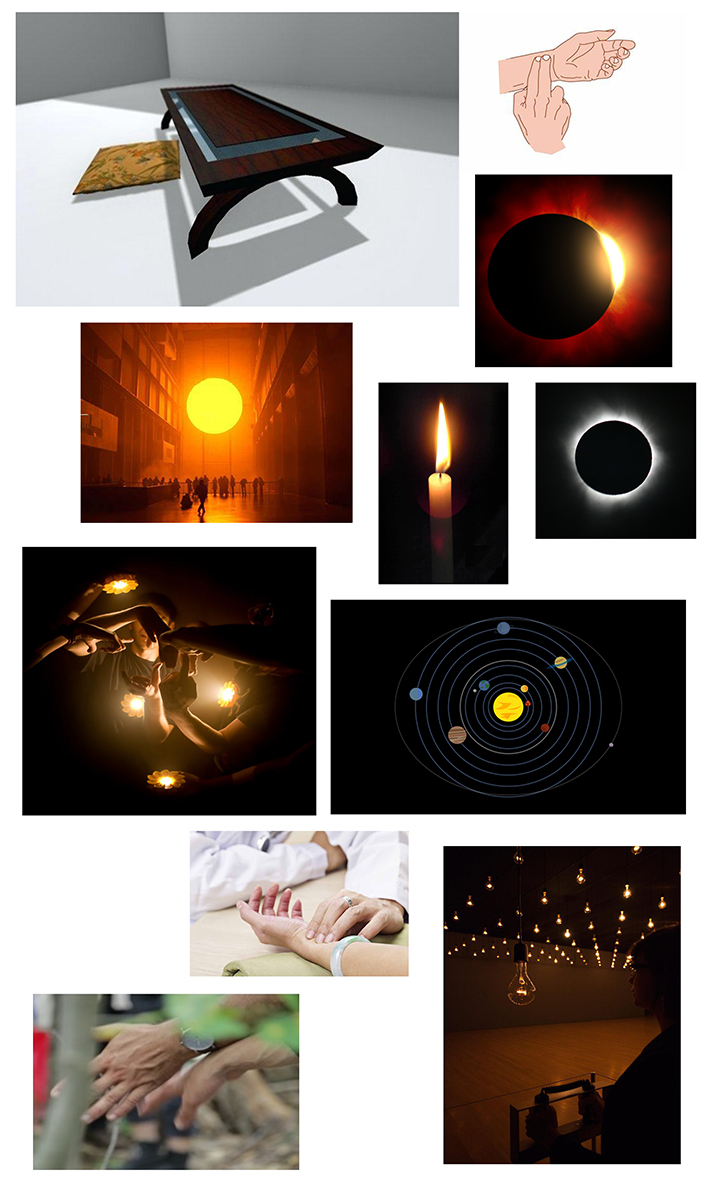
Orrery
•An Educational Kit I bought and put together:
Artist working with pulse sensor
When I searched for artists working with pulse sensor, I immediately saw Rafael Lozano- Hemmer's Pulse Room. The room contains 10000 lightbulbs, and one of them flickers when one holds onto a metal handle in front of it.
Lin Tianmiao's Reaction was a piece I experienced in person at Rockbund Art Museum. I entered an egg-like cell and placed my wrist onto a pedestal-like device, and then heard my heart beat syncing with a sound played in the cell. In front of the device there is a helix-shaped glass tube, in which liquid falls down as heart beat comes in.
Giving a sense of warmth to scientific theory:
•Jes Fan: NY based artist (sculpture, performance, video) that investigates the intersection between biology and identity.
•Olafur Eliasson's The Weather Project, Sun Lamp
Window of Sesshuji Temple in Kyoto

The amount of exterior scenery (organic, chaotic) is seen depending on how much the window is opened, similar to a curtain.
What will you design?
Meditation table
•Table: top and leg with wood joints; top with negative space that meets the gear of the orrery
•Mechanics of the orrery: gears for the orbital movement; center connected to a stepper motor
•Stepper motor movement: programmed to move (x) steps every minute
•Light source (lamp): synchronizes with the pulse sensorr
•Two sculptural faces: one orbit around another; another orbits around the center (light source)
Kneeing section
Kneeing: place the knees and a cushion
Sculptural hand: placing the pulse sensor; big enough also for the viewer to rests the other fingers on
What materials and components will be used?
Meditation table and mechanics: plywood
Kneeing section and sculpural hand pedestal for the pulse sensor: plywood, cushion
Two sculptural faces: casted with rubber mould for capturing fine details; pour resin
Shell of the LED: 3d printed or casted with rubber mould using clear resin TBD
Boards: LED board, stepper motor mother board, pulse sensor board: SIYUno for the LED board and the pulse sensor board
Power
Where will come from?
Except for the cushion, the stepper motor and the pulse sensor, all will be made by myself at the fab lab. Here are some notes from my notepad:
full sheet of ply: buy plywood long stick a small block of plywood for the hand resin: fablab rubber (smoothon): fablab 2-4 x wax block, two for lamp*might 3d print: one for one head one for other head): buy 3d print filament: fablab pcb board led and touch sensor mother board: new arduino board or my siyuno (already made)+ power (vcc+gnd+output pin for touch pad / three pins for led) led board (transistor for 3 leds) NOTE: need to figure out where to place transistor Pulse sensor -> bought stepper motor mother board + power
How much will they cost?
Wax : 50 RMB per wax block Plywood : around 600-800 RMB for full sheet Resin : around 100 RMB for part A + part B Other materials are materials at the fab lab *detailed material sheet will be written
What parts and systems will be made?
See diagram in above section.
What processes will be used?
CNC Machining/Laser Cutting (thickness of the material/dimension) -> TBD
• Meditation table
Electronic Design
• PCB board making and soldering: led board, stepper motor mother board
Woodworking
•Hand where the sensor is placed. I will refer to THIS tutorial for the woodworking part of the hand
•Hand will be attached onto a platform for placing the kneeing cushion
Moulding and Casting: two heads + holes (size of the rounded wood stick)•Mould: rubber mold
•Casting: pouring resin
3D Printing
•Light case
What questions need to be answered?
What kind of gear to make for the movement I want? How will the step be converted to delay? What is the size of the table and how is it related to the eyes and the body? What is the size of the pulse sensor pedestal and how is it related to the eyes and the body? How will the knee be placed? How does the pulse synchronize with the light but still gives enough attention to the light and shadow when viewing (afraid the shakiness of the heart rate would affect too much of the solitary experience)? Conversion between delay and time and step (stepper motor)?
How will it be evaluated?
The orrery mechanics works with the stepper motor.
The pulse sensor synchronizes with the led light without feeling distracted, but belongs to the conceptual purpose of the work.
The overall visual engagement speaks for the concept.
Time Distribution
table 40% •planning mechanics •initial cad •prototype making •final cad •actual making 3d print and or casting 25% •cad •printing/waiting time for mould and cast pcb board 20% •board for led and pulse sensor -> LIKELY USE SIYUNO •led board •stepper motor board programming 10% •sync pulse and led brightness •stepper motor to move x step in y delay finishes and assembly (sanding varnishing assembly) 5%
Workflow
Before week of Fan5 Seoul (April 23 - May 5)
make a cad model to understand dimensions make laser cut model of all the mechanics in the table(a prototype of the table in plywood)and 3d print the prototype heads OTHER TASKS personal things (moving apartment), catch up: week 4 with laser cut prototype
After Fan5 Seoul (May 13 - End of May)
1. finalizes dimensions 2. prep laser cut/cnc file for the final table -》cut 3. make all the pcb boards (the pcb board dimension can be adjusted accordingly to the final table size) 4. programming pulse sensor and light, stepper motor *LOG AS I WORK OTHER TASKS: personal things (moving apartment, finish two paintings in progress, studio visit), machine building (group project), wildcard (flex pcb + LED + sewing -> wearable TBD)
Two Weeks before presentation (June 1 - June 18)
1. cast/3d print the lamp case and heads and the hand 2. make the kneeing + sculptural hand section * if possible, finish this part in May 3. finishes 4. prepare presentation *LOG AS I WORK OTHER TASKS: catch up: details on casting and moulding week with the heads, polish fab academy website